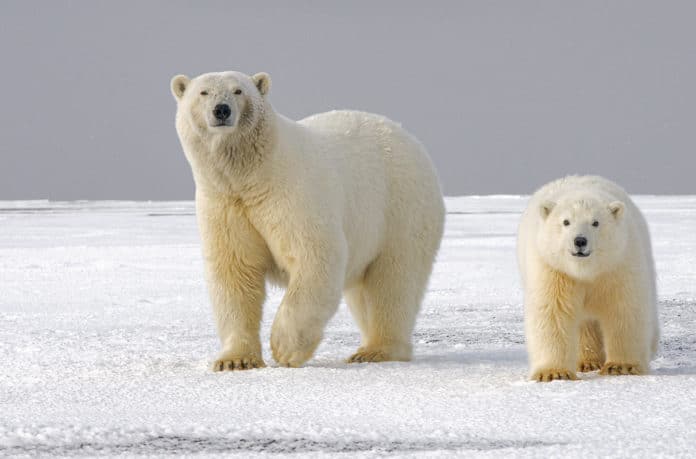An animal’s home range represents the area required to obtain resources for survival and reproduction. Many factors influence an animal’s home range size, including energy and reproductive requirements, food distribution and density, shelter, and competition.
Habitat fragmentation, which involves the separation of a continuous habitat into smaller non-continuous pieces, can disrupt biological processes and alter the distribution of wildlife.
In recent years, polar bears in the Beaufort Sea have had to travel far outside their traditional arctic hunting grounds, contributing to an almost 30% decrease in their population.
According to a recent study in the journal Ecosphere, the bears’ home range was around 64% larger from 1999-2016 than it was in 1986-1998.
“Having to travel farther means these bears are expending more energy which can threaten their survival,” said Anthony Pagano, a postdoctoral researcher in Washington State University’s School of the Environment and lead author of the study. “If we want to preserve the habitat of these amazing mammals, then we need to focus on the root of the problem, which is slowing global climate change.”
For the study, Pagano and colleagues from the U.S. Geological Survey used satellite tracking data to analyze the movement patterns of female polar bears from 1986-2016 in the Beaufort Sea area north of Alaska.
Over the last two decades, polar bears have to travel farther north of their traditional hunting grounds on the continental shelf to remain on their receding sea ice habitat.
Declines in Arctic sea ice result in both fragmentation and disappearance of the sea ice habitat upon which polar bears rely for hunting seals, which threatens to disrupt polar bear movement patterns, mating ecology, and prey accessibility.
Extending around 100 miles north of Alaska and Canada, the continental shelf is a shallow water habitat that contains plenty of fish for the bears’ favorite prey, seals.
During the early summer, when seals are weaning their pups and are most vulnerable to attack, polar bears will often double their body weight from eating fatty meat.
“The combined impact of having to move farther and farther north with the ice in the summer and then having to move back in the fall and winter as the ice freezes is taking a major toll,” Pagano said. “Our work highlights the worrying impact of sea ice decline on polar bear movement patterns.”
Another interesting finding of the study is that around 20% of the polar bear population in the Beaufort Sea is preceding their traditional sea ice hunting grounds altogether in the summer and fall. These bears are moving inland along the Alaskan and Canadian coast, looking for food such as carrion, berries, and sometimes even bowhead whale carcasses left on the shore by indigenous residents who hunt large aquatic mammals.
“Sometimes you’ll have 50 to 100 polar bears that congregate around these whale carcasses and compete with each other for food,” Pagano said. “As more and more bears move on land, I suspect there’ll be a lot more competition for these food resources, and we’ll probably start seeing further decreases in abundance and survival.”
The increase in size has accompanied a northward shift for bears that summered on the sea ice. In the summer, polar bears encounter more open water within their home ranges and less preferred sea ice habitat. In contrast, summer land use has likely enabled some bears to remain in proximity to near-shore hunting habitats, along with access to supplemental food resources, and has facilitated a markedly smaller annual home range relative to bears that remain on the summer sea ice. Summer sea ice extent is forecasted to continue to decline. Continued declines in sea ice are likely to challenge S.B. polar bears to either further increase their home ranges or move to land in the summer.
Moving forward, Pagano and his colleagues with the USGS plan to conduct further studies of the polar bears moving inland to understand better how they are coping with their new terrestrial habitat.
He said the best thing humans can do to help preserve the southern Beaufort Sea’s 800 or so remaining polar bears is to focus on curbing global carbon emissions, the leading cause behind receding arctic sea ice.
Recent modeling work has shown that if regulations are enacted to reduce these emissions to avoid global warming more significant than two °C (3.6°F), it could drastically slow the decline of polar bear habitat in the arctic, which would help in turn these animals to survive.
“Coming across a polar bear while flying over the arctic in a helicopter is a surreal experience,” Pagano said. “They are incredibly massive and impressive. It is amazing to observe this animal that is so uniquely adapted to exist in this harsh arctic environment. They are worth the effort it will take to preserve them.”
Journal Reference
- Anthony M. Pagano, George M. Durner, Todd C. Atwood, David C. Douglas; Effects of sea ice decline and summer land use on polar bear home range size in the Beaufort Sea. Ecospher, DOI: 10.1002/ecs2.3768
